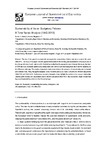Sustainability of Italian budgetary policies: a time series analysis (1862-2013)

View/
Use this link to cite
http://hdl.handle.net/2183/23450Collections
Metadata
Show full item recordTitle
Sustainability of Italian budgetary policies: a time series analysis (1862-2013)Date
2017Citation
Brady, G., & Magazzino, C. (2017). Sustainability of Italian budgetary policies: a time series analysis (1862-2013). European Journal of Government and Economics, 6(2), 126-145. https://doi.org/10.17979/ejge.2017.6.2.4326
Abstract
[Abstract] In this paper, we analyze the sustainability of Italian public finances using a unique database covering the period 1862-2013. This paper focuses on empirical tests for the sustainability and solvency of fiscal policies. A necessary but not sufficient condition implies that the growth rate of public debt should in the limit be smaller than the asymptotic rate of interest. In addition, the debt-to-GDP ratio must eventually stabilize at a steady-state level. The results of unit root and stationarity tests show that the variables are non-stationary at levels, but stationary in first-differences form, or I(1). However, some breaks in the series emerge, given internal and external crises (wars, oil shocks, regime changes, institutional reforms). Therefore, the empirical analysis is conducted for the entire period, as well as two sub‐periods (1862‐1913 and 1947‐2013). Moreover, anecdotal evidence and visual inspection of the series confirm our results. Furthermore, we conduct tests on cointegration, which evidence that a long-run relationship between public expenditure and revenues is found only for the first sub-period (1862-1913). In essence, the paper’s results reveal that Italy have sustainability problems in the Republican age.
Keywords
Public finance
Sustainability
ARDL
Italy
Sustainability
ARDL
Italy
Editor version
Rights
Atribución 4.0 España
ISSN
2254-7088






